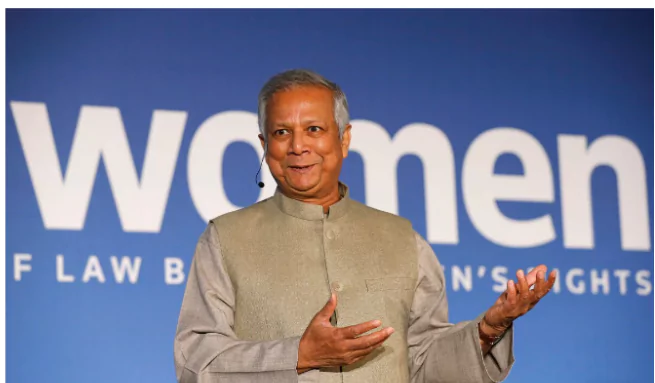Muhammad Yunus

|
Muhammad Yunus; also known as ‘Banker to the Poor’, the winner of the 2006 Nobel Peace Prize, will become the chief adviser to the interim government in Bangladesh.
About Muhammad Yunus:
- Muhammad Yunus, born on June 28, 1940, in Chittagong, Bangladesh, is a distinguished social entrepreneur, banker, economist, and civil society leader.
- Nobel Peace Prize: He rose to international prominence in 2006 when he and the Grameen Bank received the Nobel Peace Prize for their pioneering work in microcredit and microfinance.
- Work: These initiatives provide small loans to underserved entrepreneurs, empowering them to achieve economic and social development despite limited access to traditional banking services.
- Grameen Bank Formation: In response to the famine in Bangladesh in 1974, Yunus sought to make a tangible difference for the impoverished. He initiated long-term loans to help individuals start their own small businesses, which led to the establishment of the Grameen Bank and the broader movement of microfinance.
- Yunus has held various influential positions: International Advisory Group for the Fourth World Conference on Women (1993- 1995), the Global Commission on Women’s Health, and the UN Expert Group on Women and Finance.
- United Nations Foundation Member: From 1998 to 2021, he was a board member of the United Nations Foundation, contributing to a range of UN initiatives.
- Accolades: Mohamed Shabdeen Award for Science, the World Food Prize, the King Hussein Humanitarian Leadership Award, the Volvo Environment Prize, the Nikkei Asia Prize for Regional Growth, the Franklin D. Roosevelt Freedom Award, and the Seoul Peace Prize.
|
Quality Council of India introduces QCI Surajya
|
The Quality Council of India (QCI) is introducing the QCI Surajya Recognition & Ranking Framework
About QCI
- Quality Council of India was set up in 1997, jointly by the Government of India and the Indian Industry represented by the three premier industry associations
- Associated Chambers of Commerce and Industry of India (ASSOCHAM)
- Confederation of Indian Industry (CII)
- Federation of Indian Chambers of Commerce and Industry (FICCI)
About QCI Surajya Recognition & Ranking Framework:
- About: The QCI Surajya Recognition & Ranking Framework, beginning with the August 2024 rankings, sets a new benchmark for excellence across the nation.
- Ranking Basis: The rankings have been compiled, incorporating both monthly and cumulative figures across various initiatives to ensure a comprehensive and balanced evaluation.
- AIM: It aims to create a developed India by recognizing and rewarding states and organizations that excel in quality and innovation.
- With a strong emphasis on enhancing collaborative governance and fostering sustainable development, this framework is a significant step towards building a prosperous and quality-driven Viksit Bharat.
- This framework is categorized under four pillars: Shiksha (Education), Swasthya (Health), Samriddhi (Prosperity) & Sushasan (Governance)
- Shiksha: Enhancing the quality of education (Shiksha) through robust accreditation and certification processes.
- Swasthya: Guaranteeing superior healthcare (Swasthya) services throughout the nation and upholding the highest standards of medical care in every region.
- Samriddhi: Driving economic prosperity (Samriddhi) through quality assurance in manufacturing and industrial practices.
- Sushasan: Ensuring transparent, accountable, and responsive governance (Sushasan) that upholds the highest standards of quality.
- Rankings of States:
- In the Shiksha Rankings: Uttar Pradesh leads with the highest number of accreditations, assessments, and ratings.
- Delhi, as a union territory, also ranks prominently.
- In the Swasthya category: Chhattisgarh, Karnataka, Kerala, Rajasthan, Mizoram and Manipur stand out with complete certification in the Ayushman Arogya Yojana (NABH)
- Tamil Nadu and Maharashtra lead in the Medical Entry Level Testing Labs (MELT) rankings (NABL).
- Among the union territories: Chandigarh excels with 100% certification in Ayushman Arogya Yojana, and Jammu & Kashmir shows commendable performance with a 71.43% certification rate.
- The Surajya Recognition acknowledges the outstanding performance and commitment to quality by states and organisations in these vital areas.
|
Nandini Sahakar Yojana
|
Recently, the Minister of Cooperation has provided details about the Nandini Sahakar Yojana.
About Nandini Sahakar Scheme:
- Nandini Sahakar Scheme by National Cooperative Development Corporation (NCDC) is a women focused framework of financial assistance, project formulation, hand-holding and capacity development aimed at assisting women cooperatives to take up business model based activities under the purview of NCDC.
- Limits: There is no minimum or maximum limit on financial assistance to projects by women cooperatives.
- Objective: The scheme is a framework of assistance to improve socio-economic status of women. It supports entrepreneurial dynamism of women through women cooperatives.
- Features:
-
- Assistance & Internet Subvention: Any cooperative society, having minimum 50% women as primary members, with three months in operation is eligible to apply for assistance which will be in the form of credit linkage for infrastructure term loan and working capital, dovetailed with subsidy or interest subvention from other schemes of Government / Agencies.
- Incentives: As an incentive, NCDC provides 2% interest subvention on its rate of interest on term loan portion for new and innovative activities and 1% interest subvention on its rate of interest on term loan portion for all other activities resulting in lower borrowing costs.
|
Monkeypox

|
Recently, Democratic Republic of Congo witnessed a rise in mpox cases along with a rapid spread in Kenya and several other African countries, raising concerns among health authorities.
About Monkeypox:
- Mpox (formerly known as monkeypox) is a disease caused by infection with a virus, known as Monkeypox virus. This virus is part of the same family as the virus that causes smallpox.
- Potential reservoirs: Rodents and primates
- Common symptoms: Skin rash or mucosal lesions which can last 2–4 weeks accompanied by fever, headache, muscle aches, back pain, low energy, and swollen lymph nodes.
- Incubation period: The incubation period (the period between exposure to an infection and the appearance of the first symptoms) of monkeypox is usually from 6 to 13 days but can range from 5 to 21 days.
- Transmission between humans:
- Through close contact including sexual contact
- Exposure to infected bodily fluids or lesions
- Current Spread: The mpox outbreak was last reported during 2022-23 and has intensified since then.
- Initially, the disease was limited to the Democratic Republic of Congo (DRC) but has now- spilled over to nine other African countries including Burundi, Central African Republic, Rwanda and South Africa.
- Name changed in 2023:
- Monkeypox will now be known as Mpox, the World Health Organization (WHO) has announced, after complaints over racist and stigmatising language linked to the virus’s name.
- The old term will be used alongside the new one for a year till 2024 before being phased out.
|
Rashtriya Vigyan Puraskar
|
G Padmanabhan, the Chandrayaan-3 team, Annapurni Subramaniam, and 30 others have been chosen for the inaugural Rashtriya Vigyan Puraskar (RVP)
About Rashtriya Vigyan Puraskar (RVP):
- Announcement: Last Year, the Government of India announced the “National Science Awards” in the field of science, technology and innovation .
- About: The National Awards recognise outstanding and inspiring scientific, technological and innovation contributions of researchers, technologists and innovators .
- Awards 2024: 33 Rashtriya Vigyan Puraskar awards will be given this year; 13 scientists will get the Vigyan Shree award and 18 the Viyan Yuva award
- Categories: The awards will be given in the following four categories :
- Vigyan Ratna ( VR ) : A maximum of three awards will be awarded to recognise lifetime achievements and contributions in the field of science and technology .
- Vigyan Shri ( VS ) : A maximum of 25 awards will be awarded to recognise outstanding contribution in the field of Science and Technology .
- Vigyan Yuva : Shanti Swarup Bhatnagar ( VY – SSB ) Awards : A maximum of 25 awards will be given to recognize and encourage the talent of young scientists who have made exceptional contributions in the field of science and technology
- Science Team ( VT ) Awards : A maximum of three awards may be awarded to a team of three or more scientists / researchers / innovators who have made exceptional contributions while working in a team in the field of science and technology .
Notable Awardees:
- G Padmanabhan: At 86, G Padmanabhan, a renowned biochemist known for his work on the malaria parasite, has been named a Vigyan Ratna, recognizing his lifetime achievement in science.
- He has also been honored with the Padma Shri and Padma Bhushan.
- Chandrayaan-3 Team: The team behind Chandrayaan-3, which successfully landed India’s first spacecraft on the Moon last year, has been awarded the Vigyan Team award for their collaborative research work.
|
![]() 8 Aug 2024
8 Aug 2024
